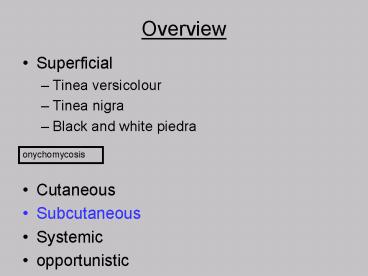Overview - PowerPoint PPT Presentation
1 / 18
Title:
Overview
Description:
hyaline. Phaeo/dematiaceous. others. Subcutaneous mycoses (M4.1) ... Eumycetoma (dematiaceous and hyaline) Madurella mycetomatis. Pseudallescheria boydii ... – PowerPoint PPT presentation
Number of Views:134
Avg rating:3.0/5.0
Title: Overview
1
Overview
- Superficial
- Tinea versicolour
- Tinea nigra
- Black and white piedra
- Cutaneous
- Subcutaneous
- Systemic
- opportunistic
onychomycosis
2
Fungi by the Tristram scheme
3
Subcutaneous mycoses (M4.1)
- Subcutaneous tissue (beyond just skin)
- Aetiology - is diverse / environmental
- Organisms of low innate pathogenicity
- traumatic implantation, chronic, non
transmissible. - Pathology
- May be a non specific foreign body reaction
- May be a distinct clinical / microbial entity
4
Subcutaneous mycoses (M4.1a)
- Sporotrichosis
- Distinct disease with Sporothrix schenkii.
- Chromoblastomycosis
- Distinct disease with various dematiaceous fungi
AND specific tissue fungal morphology. - Mycetoma
- Eumycotic and actinomycotic
- Specific clinical presentation.
- Phaeohyphomycosis
- Brown hyphae in tissue
5
Sporotrichosis (M4.2)
- Sporothrix schenkii - dematiaceous/dimorphic
- Reservoir - soil, decaying vegetation, worldwide
distribution - Transmission
- Traumatic implantation, occupational
- Clinical
- Subcutaneous nodules
- Suppuration, ulceration and drainage
- Spread down lymphatic course.
6
Laboratory diagnosis (M4.3)
- Direct microscopy
- Poor sensitivity. Sparse yeast cells, asteroid
body - Culture
- Good yield and grows on most media
- Room temp for isolation (37oC is slower)
- Identification
- A white to grey mold becoming moist
- Hyaline hyphae, mixed hyaline/demat conidia
- Need in vitro conversion to yeast
7
Chromoblastomycosis (M4.4)
- Classified by presence of fungal tissue form AND
clinical presentation, NOT aetiology - Aetiology - any dematiaceous fungi
- e.g Cladosporium, Fonsecaea, Phialophora
- NOT all subcutaneous infections with these
organisms are chromoblastomycosis
8
Chrmoblastomycosis (M4.4b)
- Tissue form is SCLEROTIC body
- Dematiaceous thick walled yeast cell
- Non budding, but multiplane septation
9
Chromoblastomycosis (M4.5)
- Reservoir and transmission
- Traumatic implantation from decaying vegetation,
but chronicity dictates that it is uncommon in
developed countries. - Clinical presentation is distinctive
- Hyperkeratosis and hyperplasia
- Tumour like warty cauiliflower growths
- Very slow progression
- Uncommon in children (? time or immune)
- Treatment - antifungals / surgery / heat
10
Chromo - diagnosis (M4.6)
- Direct microscopy
- Sclerotic bodies (usually easily seen)
- Occasional hyphae
- Culture
- Will grow on most media (some are cyclo R)
- Slow growing (4-6 wks)
- Dark velvety colonies (similar)
- Contamination can be a problem
11
Chromo - diagnosis (M4.6b)
- Identification
- Sclerotic cells are identical
- NO dimorphism in vitro
- Complex and variable conidiation
- Hyphael elements are clearly dematiaceous
12
Mycetoma (M4.7)
- Terminology
- Eumycetoma if fungal, actinomycetoma if caused by
an actinomycete. - Characterised by
- Swollen tumour like body sites with internal
lesions. - Draining sinuses, granule formation.
- Epidemiology
- Traumatic implantation, non contagious
13
Mycetoma (M4.8)
- Clinical features
- Variable incubation period.
- Swelling hard and painless
- Local spread to contiguous tissue
- Eventual sinus formation and drainage
- Location of lesions linked to exposure
- Male to female is 31
- Therapy is poor for eumycotic but slightly better
for actinomycotic.
14
Mycetoma (M4.9)
- Eumycetoma (dematiaceous and hyaline)
- Madurella mycetomatis
- Pseudallescheria boydii
- Fusarium
- Exophiala jeanselmii
- Actinomycotic (aerobic actinomycetes)
- Actinomadura, Streptomyces, Nocardia
- Actinomycetoma Actinomyces israelii, ANO2 and
endogenous
15
Laboratory diagnosis (M4.10)
- Recover granules black, red, white
- Squash prep microscopy
- 2-6um fungal, lt0.5 actinomycetes
- Culture to cover all
- Use selective for fungi plus selective for
actinomycetes, but NOT both. - Dont forget Actinomyces
16
Identification of Actinomycetes (M4.11)
- Blood agar, BHI agar, sabs variable
- Typical colonial and microscopic morphology to
group - Identification to genus by partial acid fastness,
but speciation is difficult.
17
(No Transcript)
18
Summary
- Subcutaneous mycoses
- Sporotrichosis
- Chromoblastomycosis
- Mycetoma
- Eumycotic
- Actinomycotic
- Actinomycosis
- Phaeohyphomycosis
- Hyalohyphomycosis































